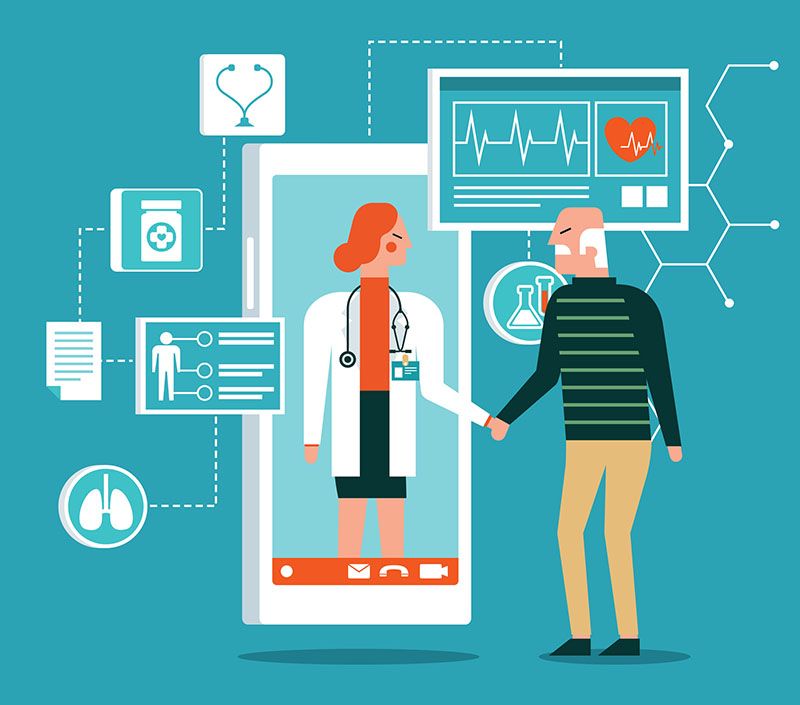Introduction:
The healthcare sector has undergone tremendous change in recent years, and the rise of telemedicine has been a notable development. Telemedicine, or telehealth, uses digital communication technology to provide remote medical services and advice. The concept is not entirely new, but the COVID-19 pandemic has led to widespread adoption and incorporation into mainstream health care. In this blog, we will explore the reasons for the rise of telemedicine, the benefits, and the challenges, Telemedicine, or telehealth, uses digital communication to provide remote medical services and advice. It has experienced wider adoption due to COVID-19. This blog post will explore its surge, benefits, challenges, and potential implications for healthcare’s future. and potential implications

The Telemedicine Boom:
The global health crisis posed by the COVID-19 pandemic has created an urgent need for innovative healthcare solutions that provide patients with treatment and reduce the risk of infection. Telemedicine emerged as a powerful solution to bridge the gap between patients and healthcare providers. \

Benefits of Telemedicine:
- Enhanced Accessibility: Telemedicine has made healthcare more accessible, especially for people living in remote or underserved areas. Patients who previously faced difficulties accessing healthcare facilities can now seek treatment through in-person counseling.
- Convenience and Time-Saving: Telemedicine eliminates the need for physical travel to medical facilities, saving both patients and healthcare providers time and effort. Waiting times are also reduced, resulting in faster access to medical advice.
- Reduced Healthcare Costs: Compared to traditional in-person visits, virtual consultations are cost-effective, benefiting patients and healthcare systems alike.
- Global Collaboration and Knowledge Sharing: Telemedicine facilitates the global exchange of medical knowledge and expertise, enabling health professionals to collaborate and learn from each other
Challenges and Limitations:
While telemedicine has great potential, it faces some challenges that need to be:
- Technological Barriers: Not everyone has the necessary technology, such as a reliable internet connection or smartphones, which can hinder the adoption of telemedicine in a community
- Patient Privacy and Data Security: The transmission of medical information via digital channels raises data privacy and security concerns. Robust measures must be implemented to protect patient data from breaches and cyber threats.
- Navigating healthcare regulations across borders can be challenging for obtaining licenses and compliance.
- Diagnostic Limitations: While telemedicine can address a wide range of medical conditions, some physical exams and diagnostic procedures still require an in-person visit.
The Future of Telemedicine:
The rapid spread and acceptance of telemedicine during the epidemic laid a strong foundation for its future development. As technology advances, we can expect more sophisticated telemedicine solutions, with advanced wearable healthcare devices, AI-driven diagnostics, and surgery including remote control Furthermore, telemedicine can be an integral part of hybrid healthcare systems, where patients can choose which appointments and appointments are realistic based on their preferences and medical needs in hospital This hybrid approach can contribute to the quality of health care delivery and improve patient outcomes.
Conclusion:
The rise of telemedicine has been a remarkable development in the healthcare industry, and with many advantages including improved accessibility, convenience and cost-effectiveness that has saved patients from the epidemic in and beyond so telemedicine is here to stay. However, addressing the challenges and ensuring safe and ethical use will be critical to unleashing the potential of telemedicine. Telemedicine improves global well-being with technology.

2 Comments
Best best best..
Pingback: The Dynamic Landscape of Politics: Navigating Through Complexity - Zarsco Blogs🚀